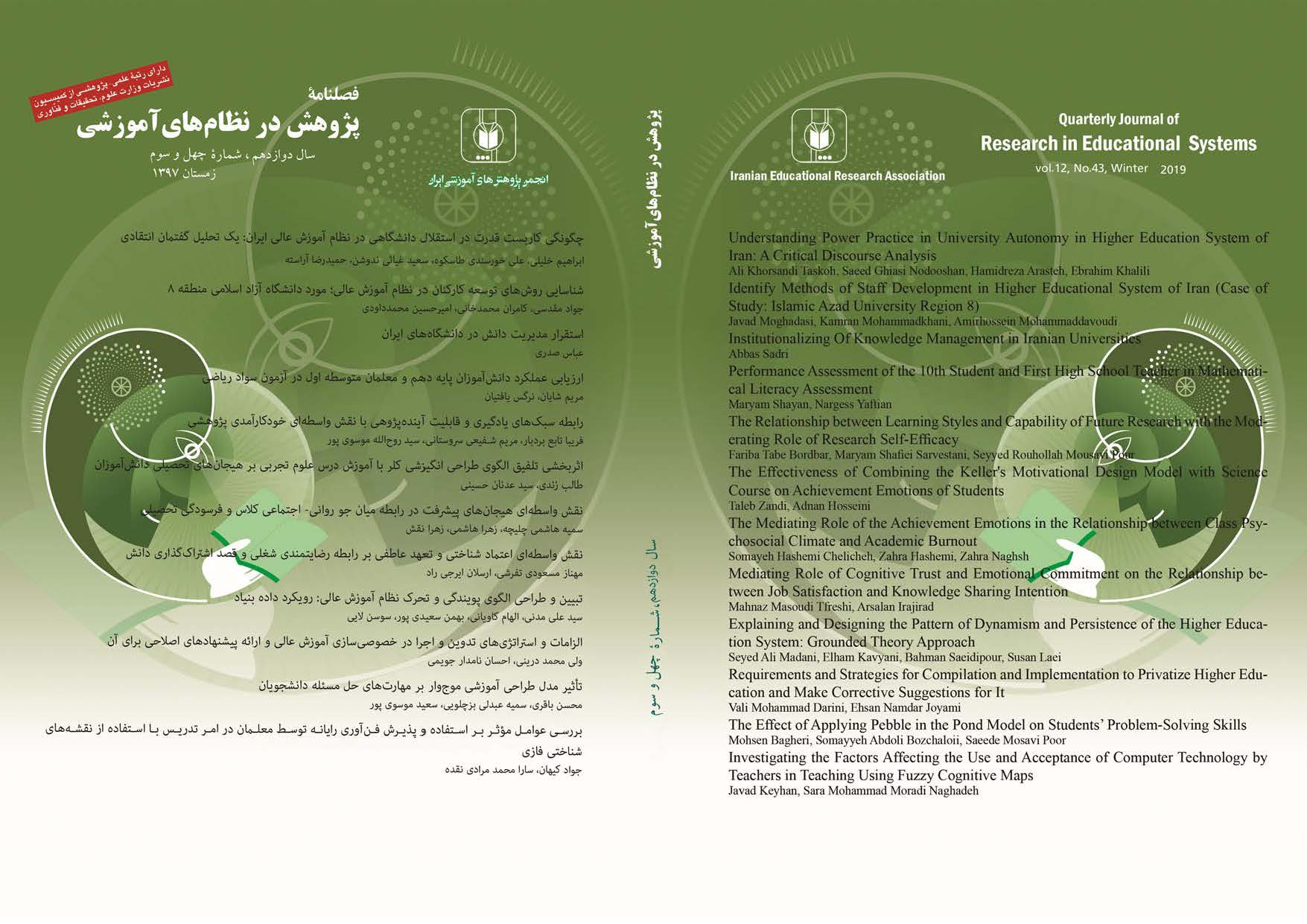ابیلی، خ. و عالیخانی، ف. (1382). بررسی عملکرد سیستم توسعه منابع انسانی در دانشکدههای علوم رفتاری و اجتماعی دانشگاه تهران. روانشناسی و علوم تربیتی، 32)2)، 57-76.
اسلامی، ی.؛ نوروزی، ط. و بدیعی، ح. (1390). بررسی تأثیر آموزشهای ضمن خدمت بر میزان توانمندسازی کارکنان دانشگاه آزاد اسلامی. رهبری ومدیریت آموزشی، دانشگاه آزاد اسلامی واحد گرمسار 5(4)، 9-22.
انصاری، م.؛ رحمانی یوشانلوئی، ح.؛ اسکویی، و. و حسینی، ا. (1390). شناسایی عوامل و طراحی مدل مفهومی توانمندسازی نیروی انسانی در وزارت ارتباطات و فناوری اطلاعات (مطالعه موردی). مدیریت دولتی، 3(7)، 23-40.
پورصادق، ن. و علی میرزایی، س. (1384). توسعه کارکنان. تهران: سارگل.
جعفریفر، ز.؛ خراسانی، ا. و رضاییزاده، م. (1396). شناسایی و رتبهبندی موانع مدرسان در آموزش و بهسازی مجازی منابع انسانی (مطالعه موردی: دانشگاه شهید بهشتی). آموزش و توسعه منابع انسانی، 4(12)، 53-78
خسرویپور، ب؛ موسوی، م. (1391). نقش آموزش و بهسازی در توانمندسازی نیروی انسانی در سازمان. ماهنامه کار و جامعه، 143، 19-29
سیدجوادین، ر. (1387). برنامهریزی نیروی انسانی. تهران: دانشگاه تهران.
فرهنگ، ا.؛ سیادت، ع.؛ هویدا، ر. و مولوی، ح. (1390). بررسی رابطة ساده و چندگانة یادگیری سازمانی و اعتماد اجتماعی در سازمان با توسعة کارکنان دانشگاههای دولتی پزشکی و غیرپزشکی جنوب شرق کشور. جامعهشناسی کاربردی، 22(1)، 159-182.
صفاری زنجانی، ن.؛ کاظمزاده بیطالی، م.؛ حسنی، م. و نماز پور، م. (1396). رابطه بین توسعه حرفهای کارکنان با خودکارآمدی آنان و نوع قدرت مدیران در دانشگاه آزاد اسلامی واحد ارومیه. فصلنامه رسالت مدیریت دولتی، 8(27)، 1-12
عباسپور، ع. (1387). مدیریت منابع انسانی پیشرفته (رویکردها، فرایندها و کارکردها). تهران: سازمان مطالعه و تدوین کتب علوم انسانی دانشگاهها (سمت).
کفری، م. (1388). راهنمای مدیران آموزش عالی: مدیریت و رهبری مؤثر در دانشگاهها و مؤسسات آموزش عالی. ترجمه دانشجویان دکتری مدیریت آموزش عالی. تهران: فراشناختی اندیشه.
ملکی، ح. (1395). شناخت عاملهای اثرگذار در ارتقای بهسازی منابع انسانی (موردمطالعه: واحد سازمان جهاد دانشگاهی استانی). فصلنامه آموزش و توسعه منابع انسانی، 3(10)، 125-145.
منتظر، غ. و فلاحتی، ن. (1394). سناریو نگاری آینده آموزش عالی ایران و کارکرد فنآوری اطلاعات در آن. فصلنامه سیاست علم و فناوری 7(1)، 47-67.
مهرعلیزاده، ی. (1383). جهانیشدن و آموزش عالی. دایرةالمعارف آموزش عالی. تهران: بنیاد دانشنامۀ بزرگ فارسی
نجفی، ح.؛ فرجاللهی، م.؛ نوروززاده، ر. و سرمدی، م. (1391). بررسی نقش نظام آموزش از دور بر توسعه منابع انسانی در دانشگاه پیام نور. فصلنامه پژوهش در برنامهریزی درسی، دانشگاه آزاد اسلامی واحد خوراسگان (اصفهان)، 9(8)، 60-73.
Allen, D. K., Brown, A., Karanasios, S., & Norman, A. (2013). How should technology-mediated organizational change be explained? A comparison of the contributions of critical realism and activity theory. Mis Quarterly, 835-854.
Cheraskin, L., & Campion, M. A. (1996). Study clarifies job-rotation benefits. Personnel Journal, 75(11), 31-36.
Carter, M. Z., Armenakis, A. A., Feild, H. S., & Mossholder, K. W. (2013). Transformational leadership, relationship quality, and employee performance during continuous incremental organizational change. Journal of Organizational Behavior, 34(7), 942-958.
Campbell. R .J. (2011). HR Development Strategies. In Developing Human Resources. ed. K. N. Wexley (Washington. DC. BNA Books. 2011). 5-1-5-34.
Dreher, G. F., & Ash, R. A. (1990). A comparative study of mentoring among men and women in managerial, professional, and technical positions. Journal of applied psychology, 75(5), 539.
Feldman, D. C. (1996). Managing careers in downsizing firms. Human Resource Management, 35(2), 145-161.
Hopkins, D. (2015). Improving the quality of education for all: A handbook of staff development activities. Routledge.
McDonnell, A., Sturmey, P., Oliver, C., Cunningham, J., Hayes, S., Galvin, M., ... & Cunningham, C. (2008). The effects of staff training on staff confidence and challenging behavior in services for people with autism spectrum disorders. Research in Autism Spectrum Disorders, 2(2), 311-319.
Nembhard, I. M., Morrow, C. T., & Bradley, E. H. (2015). Implementing role-changing versus time-changing innovations in health care: differences in helpfulness of staff improvement teams, management, and network for learning. Medical Care Research and Review, 72(6), 707-735.
Sheppeck, M. A., & Rhodes, C. A. (1988). Management Development: Revised Thinking in Light of New Events of Strategic Importance. Human Resource Planning, 11(2), 159-174.
Shneider, K. (2014). Transfer if learning in organizations. Springer Intermational puldishing, Switzerland.
Oral, B., & Sağlam, Ş. (2010). The importance of in-service training in restructuring sectors. Procedia-Social and Behavioral Sciences, 2(2), 4383-4386.
Okereke, C. I., & Nnenna, B. (2011). Training, manpower development and job performance: Perception and relevance among civil servants in Ebonyi State, Nigeria. Journal of Economics and international Finance, 3(6), 399-406.

